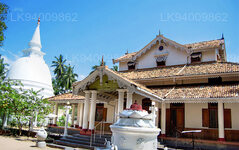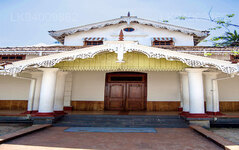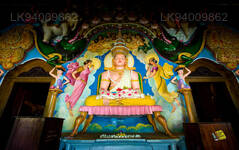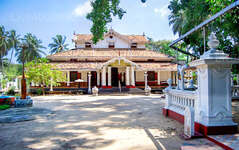
Città di Colombo
Colombo, la capitale dello Sri Lanka, è una città dinamica che fonde tradizione e modernità. Vanta un'architettura coloniale, vivaci mercati e sereni templi buddisti. Con una cucina variegata, uno skyline in continua crescita e splendide spiagge, è un vivace centro per gli affari, la cultura e il turismo, offrendo un punto di partenza ideale per esplorare le meraviglie dello Sri Lanka.
Isipathanaramaya Temple
Colombo is Sri Lanka’s capital, the center of trade and commerce for the entire country. It’s also one of the most populated cities on the island. Walking through the streets of Colombo, its quite hard to remember that the capital is a comparatively young city. It’s oldest buildings are only a few centuries old at most, and not at all comparable to the millennia-old structures that spread across Anuradhapura, Polonnaruwa and many other places within Sri Lanka. Therefore, it comes as no surprise that its oldest Buddhist Temples are only a century old or so.
Isipathanaramaya located in Havelock Town (Colombo 05) is one such Buddhist Temple that’s one of the oldest within the city. It was built in 1916, by a wealthy merchant named Duenuge Disan Pedris in the memory of his late son Captain Henry Pedris, who had been executed by the British on false allegations of incitement of the racial riots in 1915.
As the story goes, that was the year of the Sinhala-Muslim riots that started in Kandy because of reports of a group of Muslims throwing stones at a Buddhist event. It spread across the island like wildfire, and British governor came to the verge of losing control of the population. He declared martial law, and ordered a death-without-trial order on any person deemed a rioter. Unfortunately the illustrious and well-known Captain Henry, had been the object of envy for many locals. One of them, Solomon Dias Bandaranaike, who was the main native translator decided to use this opportunity to get rid of this thorn that threatened his power. He created false charges that Henry was involved in the riots and the Captain was branded traitor and executed without trial. His body was buried in dishonor, much to the distress of his family. It was only several years later that the truth came out and the late Captain was cleared of his charges.
In the meantime, Henry’s grieving father – who had been having high hopes for his heir, built a temple in his memory on a 2 hectare piece of land that had been part of the family’s properties since 1905. He also did several other good deeds that would pass on the name of his son Henry Pedris down through history, despite his early death.
Duenuge Pedris spared no effort or money when building the temple. It was built with a mixture of traditional elements and the architectural trends of the era. The murals and statues that decorate the temple are a major part of Isipathanaramaya’s attraction. The paintings were done by Master Artist Sarlis in 1920-21, and are traditional designs of Buddhist religious significance. However, they have gained prominence due to the unique, exuberant and realistic style that was used.
The temple slowly gained fame. It reached such extent that in the 1950s the street that the temple was located – Greenlands Road, and the school down the same road – Greenlands College, received a name change to Isipathana Mawatha and Isipathana Maha Vidyalaya respectively.
Today, the overall layout of Isipathanaramaya remains in its original state, with its old colonial era building, brilliant white stupa, and shady Bo Tree. The main building is beautifully maintained preserving its history. One of the most recent additions was the 12m tall standing Buddha, built in 2016 at a cost of Rs 4.5 Million.
Isipathanaramaya is well worth visiting for its historical connotations and beautiful murals.
Informazioni sul distretto di Colomb
Colombo è la città più grande e la capitale commerciale dello Sri Lanka. Si trova sulla costa occidentale dell'isola e adiacente a Sri Jayewardenepura Kotte, la capitale dello Sri Lanka. Colombo è una città vivace e trafficata, con un mix di vita moderna, edifici e rovine coloniali e una popolazione di 647.100 abitanti. La regione metropolitana di Colombo, definita dai distretti di Colombo, Gampaha e Kalutara, ha una popolazione stimata di 5.648.000 abitanti e si estende su una superficie di 3.694,20 km². Colombo è una città multietnica e multiculturale. È la città più popolosa dello Sri Lanka, con 642.163 abitanti che vivono entro i confini della città. La popolazione di Colombo è un mix di numerosi gruppi etnici, principalmente cingalesi, mori e tamil. In città vivono anche piccole comunità di persone di origine cinese, portoghese, olandese, malese e indiana, oltre a numerosi espatriati europei. La stragrande maggioranza delle aziende dello Sri Lanka ha sede a Colombo. Alcuni dei settori industriali includono prodotti chimici, tessili, vetro, cemento, pelletteria, arredamento e gioielleria. Nel centro città si trova il secondo edificio più alto dell'Asia meridionale: il World Trade Center.
Informazioni sulla provincia occidentale
La Provincia Occidentale è la provincia più densamente popolata dello Sri Lanka. Ospita la capitale legislativa Sri Jayawardenepura Kotte e Colombo, il centro amministrativo e commerciale della nazione. La Provincia Occidentale è divisa in 3 distretti principali: Colombo (642 km²), Gampaha (1.386,6 km²) e Kalutara (1.606 km²). Essendo il fulcro economico dello Sri Lanka, tutte le principali aziende locali e internazionali hanno sede in città, così come i principali negozi di stilisti e grandi magazzini, quindi preparatevi a concedervi un po' di shopping nella Provincia Occidentale. Avendo la popolazione più alta di tutte le province, quasi tutti i principali istituti scolastici dell'isola si trovano nella Provincia Occidentale. Le università della provincia includono l'Università di Colombo, l'Università di Sri Jayewardenepura, l'Università di Kelaniya, l'Università Aperta dello Sri Lanka, l'Università Buddista e Pali dello Sri Lanka, l'Università della Difesa Generale Sir John Kotelawala e l'Università di Moratuwa. La provincia occidentale ospita il maggior numero di scuole del paese, tra cui scuole nazionali, provinciali, private e internazionali.










































